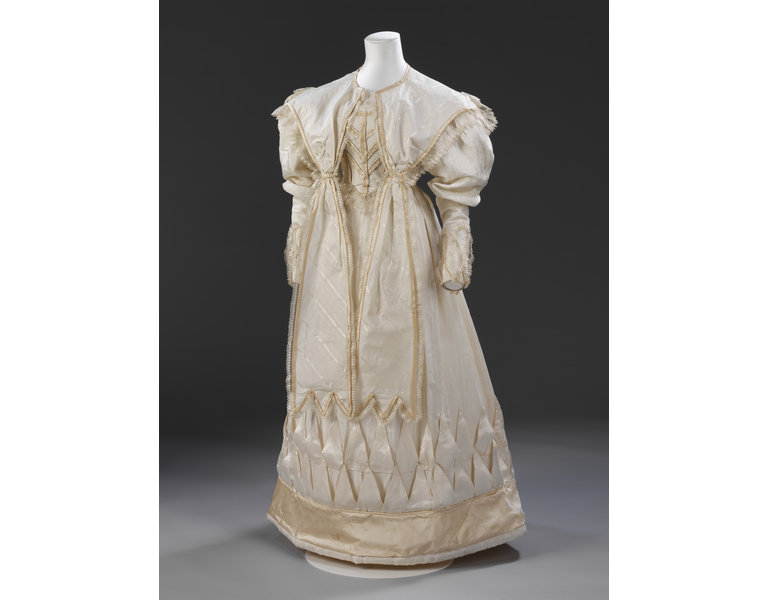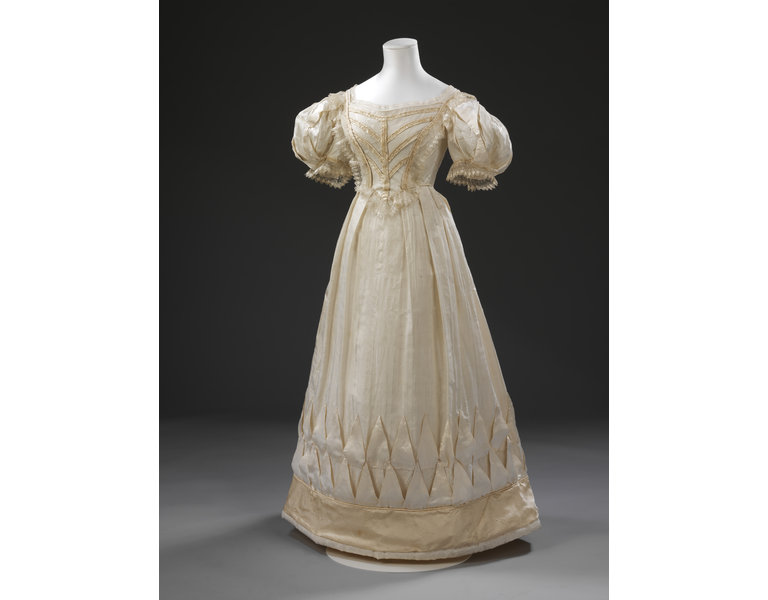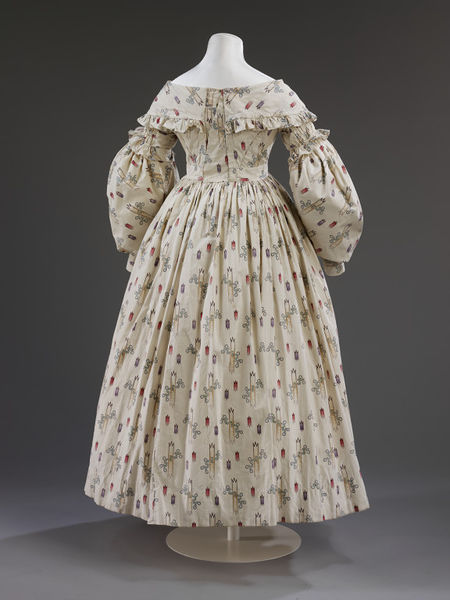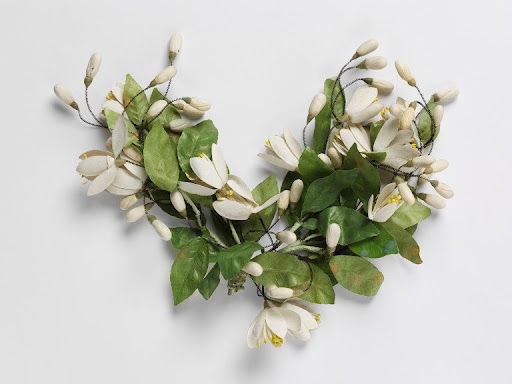In this day and age, there are several elements that conjure up the image of a wedding; the big white dress, the white veil though there is debate as to whether it is worn covering the face, and the tradition of something old, something new... however while we view these as age-old traditions, they are each one younger than the time span of the Western Australian Museum's wedding dress exhibition Unveiled: 200 years of Wedding Glamour from the Victoria and Albert Museum in London. Instead, the traditions relating to bridal wear have evolved over the last 200 years like the very fashions used to illustrate them.
Queen Victoria of England is often attributed with popularising the wearing of white by the bride at weddings. However although she increased its popularity, white was already a popular choice with brides dating back to around the turn of the 19th century. The earliest fashion plate depicting a white wedding dress dates is French and dates to 1813 while an English one is known to exist for 1816. In this the bride is dressed in a white gown, complete with the lace veil thrown back of her face and cascading down her back. The reason the bride is depicted in white is because for those who could afford it, white was worn to indicate the wealth associated with the marriage. For Royalty and the Aristocracy, gold or silver threaded cloth was used. For those who couldn't afford that, the next level down was white cloth, for its use indicated a marriage with the wealth to afford servants to launder your clothes for you. It must be remembered, this was a time when bridal gowns were not worn once as they are today, but became the bride's Sunday best or an evening dress for the first few years of her marriage and therefore needed to be laundered frequently.
In Unveiled this lifespan of the wedding dress is visible in several of the gowns through their versatility. One of the earliest gowns in the exhibition, dated to 1828, were designed to be worn with a high neckline and long sleeves for the wedding service (possibly in keeping with the requirements of church) but possessed a removable pelisse that allowed for a lower décolletage and sleeves that could be removed, revealing short puffed sleeves encased within.


In later gowns dating to the mid 19th century the gowns often came with an additional bodice to provide the low scooped neckline and short sleeves required in evening wear.
 Those who couldn't afford white were likely to have a new dress made (or make it themselves), but in a fabric that was more practical for the social status of the bride and the dress's future use. It is for this reason that the Western Australian Museum has a brown satin wedding dress and the exhibition contains the cotton dress of a farmer's wife.
Those who couldn't afford white were likely to have a new dress made (or make it themselves), but in a fabric that was more practical for the social status of the bride and the dress's future use. It is for this reason that the Western Australian Museum has a brown satin wedding dress and the exhibition contains the cotton dress of a farmer's wife.
 Similar to the early use of white, Orange Blossoms were another indication of the wealth associated with the marriage. Orange Blossom is the flower of the Orange, a plant that prefers the warmer climate of Valencia, Spain to that of England. For this reason, real orange blossoms had to be imported or cultivated at great cost in glasshouses. However, because Queen Victoria had made them fashionable, brides took to carrying and wearing wreaths of artificial orange blossoms perfumed for greater realism. These were fashioned from cotton, feathers or wax, though under the heat of candles, the later had a tendency to melt...
Similar to the early use of white, Orange Blossoms were another indication of the wealth associated with the marriage. Orange Blossom is the flower of the Orange, a plant that prefers the warmer climate of Valencia, Spain to that of England. For this reason, real orange blossoms had to be imported or cultivated at great cost in glasshouses. However, because Queen Victoria had made them fashionable, brides took to carrying and wearing wreaths of artificial orange blossoms perfumed for greater realism. These were fashioned from cotton, feathers or wax, though under the heat of candles, the later had a tendency to melt...
 During the Victorian era, orange blossoms also gained symbolism through the ascendency of a Language of Flowers. In what became the height of fashion and was even incorporated into Queen Victoria's everyday conversation, each flower was attributed a meaning, and the flowers worn on the wedding day were used to express the emotions of the bridal couple and the hopes and expectations of the year ahead. For example, the pea pods on a veil dating to circa 1850 are symbolic of fruitfulness and happiness. The orange blossom many brides continued to wear was symbolic of purity, chastity and loveliness (your purity equals your loveliness), while the myrtle also popularised by Queen Victoria symbolised love when apart and fertility. This reference to fertility possibly derived from the plant's association with the Roman goddesses Venus and Ceres, but also stemmed from the ease with which myrtle sprigs took root. In fact the sprig Queen Victoria carried at her wedding was planted and has provided the myrtle sprigs carried by subsequent royal brides including Catherine Middleton at her wedding to Prince William of Wales.
During the Victorian era, orange blossoms also gained symbolism through the ascendency of a Language of Flowers. In what became the height of fashion and was even incorporated into Queen Victoria's everyday conversation, each flower was attributed a meaning, and the flowers worn on the wedding day were used to express the emotions of the bridal couple and the hopes and expectations of the year ahead. For example, the pea pods on a veil dating to circa 1850 are symbolic of fruitfulness and happiness. The orange blossom many brides continued to wear was symbolic of purity, chastity and loveliness (your purity equals your loveliness), while the myrtle also popularised by Queen Victoria symbolised love when apart and fertility. This reference to fertility possibly derived from the plant's association with the Roman goddesses Venus and Ceres, but also stemmed from the ease with which myrtle sprigs took root. In fact the sprig Queen Victoria carried at her wedding was planted and has provided the myrtle sprigs carried by subsequent royal brides including Catherine Middleton at her wedding to Prince William of Wales.


Queen Victoria of England is often attributed with popularising the wearing of white by the bride at weddings. However although she increased its popularity, white was already a popular choice with brides dating back to around the turn of the 19th century. The earliest fashion plate depicting a white wedding dress dates is French and dates to 1813 while an English one is known to exist for 1816. In this the bride is dressed in a white gown, complete with the lace veil thrown back of her face and cascading down her back. The reason the bride is depicted in white is because for those who could afford it, white was worn to indicate the wealth associated with the marriage. For Royalty and the Aristocracy, gold or silver threaded cloth was used. For those who couldn't afford that, the next level down was white cloth, for its use indicated a marriage with the wealth to afford servants to launder your clothes for you. It must be remembered, this was a time when bridal gowns were not worn once as they are today, but became the bride's Sunday best or an evening dress for the first few years of her marriage and therefore needed to be laundered frequently.
In Unveiled this lifespan of the wedding dress is visible in several of the gowns through their versatility. One of the earliest gowns in the exhibition, dated to 1828, were designed to be worn with a high neckline and long sleeves for the wedding service (possibly in keeping with the requirements of church) but possessed a removable pelisse that allowed for a lower décolletage and sleeves that could be removed, revealing short puffed sleeves encased within.


In later gowns dating to the mid 19th century the gowns often came with an additional bodice to provide the low scooped neckline and short sleeves required in evening wear.
 Those who couldn't afford white were likely to have a new dress made (or make it themselves), but in a fabric that was more practical for the social status of the bride and the dress's future use. It is for this reason that the Western Australian Museum has a brown satin wedding dress and the exhibition contains the cotton dress of a farmer's wife.
Those who couldn't afford white were likely to have a new dress made (or make it themselves), but in a fabric that was more practical for the social status of the bride and the dress's future use. It is for this reason that the Western Australian Museum has a brown satin wedding dress and the exhibition contains the cotton dress of a farmer's wife.
This later gown is a rarity in the Victoria and Albert collection because it belongs to a working class woman and has survived, as opposed to being worn until the fabric gave out. For Sarah Maria Wright a white dress in the latest fashions was impractical so what she did was construct a dress in a style that was more than a couple of years old but one more befitting her rural setting, and in a fabric that was not only appropriate for a farmer's wife but would have been easier to maintain. To keep it modern, Sarah chose a fashionable up-to-date fabric with a print that has been dated to c1840, within a year of her wedding. This dress also confirms that the gown was worn again after the wedding for down the back of the bodice there is an approximately 12cm wide insertion, possibly to allow the gown to be worn during the first few months of pregnancy.
In 1840 Queen Victoria married Prince Albert in a profusion of lace, white, orange blossoms and myrtle, establishing a fashion that is still being propagated to this day. The lace that decorated her skirts and was worn as a veil was Honiton lace, an exquisite local lace that supported and stimulated the British cottage industry.
It was in the Victorian era that the symbolism of the white wedding dress changed to acquire the current meaning of purity and virginity. It is worth wondering if this was a result of the changing emphases of Victorian morals. Did the increased emphasis on monogamy, childhood and the immediate family result in brides wearing white to 'prove' their purity and virginity thereby guaranteeing the paternity of her children and her suitability as their role model through the innocence of their childhood?
In a similar way, did the increased popularity in the 1920s of wearing the veil to cover the brides' face as she walked down the aisle stem from the looser morals of the age and a desire to illustrate a personal modesty and purity in spite of the world around? Though we now consider veils to be a standard piece of bridal wear, this is a very recent tradition. In the early 19th century, veils would be worn as a fashion accessory by the bride, the bridesmaids and even some of the wedding guests. It was only later that they became wedding accessories, wore as an alternative to the bonnet as the obligatory head covering to a church wedding.
It was in the Victorian era that the symbolism of the white wedding dress changed to acquire the current meaning of purity and virginity. It is worth wondering if this was a result of the changing emphases of Victorian morals. Did the increased emphasis on monogamy, childhood and the immediate family result in brides wearing white to 'prove' their purity and virginity thereby guaranteeing the paternity of her children and her suitability as their role model through the innocence of their childhood?
In a similar way, did the increased popularity in the 1920s of wearing the veil to cover the brides' face as she walked down the aisle stem from the looser morals of the age and a desire to illustrate a personal modesty and purity in spite of the world around? Though we now consider veils to be a standard piece of bridal wear, this is a very recent tradition. In the early 19th century, veils would be worn as a fashion accessory by the bride, the bridesmaids and even some of the wedding guests. It was only later that they became wedding accessories, wore as an alternative to the bonnet as the obligatory head covering to a church wedding.
Catherine Middleton utilised this Language of Flowers at her 2011 wedding, with her bouquet comprising of Ivy; symbolic of Fidelity and Friendship, Myrtle; symbolic of Love when apart, Hyacinth; Constancy and Unobtrusive loveliness, Lily of the Valley; Reciprocation of happiness and Sweet William; symbolic of Gallantry.
 This language of flowers was not only utilised by the brides, but also by the grooms in their outfits. We often assume that in the Victorian era the groom just wore his ordinary clothes. This is known to be an inaccurate assumption, not only due to the existence of advertisements for wedding shirts and waistcoats but also through the history of some of the articles within the collection. One particular waistcoat contains a handwritten label attesting to its wear by a bridegroom.
This language of flowers was not only utilised by the brides, but also by the grooms in their outfits. We often assume that in the Victorian era the groom just wore his ordinary clothes. This is known to be an inaccurate assumption, not only due to the existence of advertisements for wedding shirts and waistcoats but also through the history of some of the articles within the collection. One particular waistcoat contains a handwritten label attesting to its wear by a bridegroom.  Another indication of the providence of some articles as wedding wear is through the presence of the language of flowers in the fabric or embroidery of the article. On one of the waistcoats, lily of the valley and forget me-nots have been hand stitched around the front edge, the former symbolic of reciprocation of happiness and the later true love or forget-me-not. A third example of the use of the language of flowers is in the white lilac decoration on a bonnet. This was symbolic of youth and may have indicated that the bride was marrying her first love or childhood sweetheart, or have just been rather young at her wedding. By the end of the 19th century, much of this symbolism had faded, or disappeared completely. Even among the more natural Aesthetic ideals the depiction of flowers had become purely ornamental. Orange Blossoms were still present at weddings, in a stylised fashion, but it is more likely that this was because they had become a part of the wedding tradition as opposed to due to their symbolic meaning. Other elements came to the forefront, emphasising instead the brides' personality and own interests, but the language of flowers did not die out entirely. Even today, it still plays a small role in some fashion labels and is remembered (or at least accessible) enough to provided additional meaning and symbolism to the royal wedding of the Duke and Duchess of Cambridge.
Another indication of the providence of some articles as wedding wear is through the presence of the language of flowers in the fabric or embroidery of the article. On one of the waistcoats, lily of the valley and forget me-nots have been hand stitched around the front edge, the former symbolic of reciprocation of happiness and the later true love or forget-me-not. A third example of the use of the language of flowers is in the white lilac decoration on a bonnet. This was symbolic of youth and may have indicated that the bride was marrying her first love or childhood sweetheart, or have just been rather young at her wedding. By the end of the 19th century, much of this symbolism had faded, or disappeared completely. Even among the more natural Aesthetic ideals the depiction of flowers had become purely ornamental. Orange Blossoms were still present at weddings, in a stylised fashion, but it is more likely that this was because they had become a part of the wedding tradition as opposed to due to their symbolic meaning. Other elements came to the forefront, emphasising instead the brides' personality and own interests, but the language of flowers did not die out entirely. Even today, it still plays a small role in some fashion labels and is remembered (or at least accessible) enough to provided additional meaning and symbolism to the royal wedding of the Duke and Duchess of Cambridge.
No comments:
Post a Comment